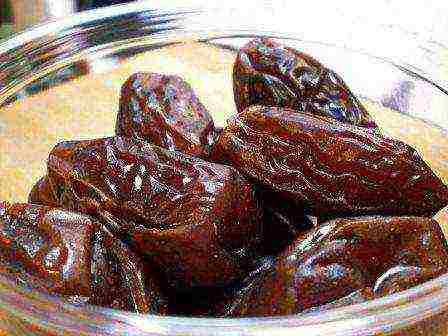Content [show]
Alstroemeria, a spectacular tuberous plant with tall stems, crowned with exotic flowers resembling medium-sized lilies, "descended" into European gardens and greenhouses from the Chilean and Peruvian mountains in the 18th century.
Alstroemeria
Since then, numerous varieties of "Peruvian lilies" have been developed with flowers of all shades, combinations and transitions of white, pink, red, yellow and purple. In the inner, central part, each such flower keeps a wild striped speck, reminiscent of a distant mountain homeland. In the cut, they can stand from two weeks to a month.
Alstroemeria flowers
Despite its origin from very far abroad, alstroemeria is able to grow and bloom well in greenhouses, rooms and gardens of the middle lane.
Alstroemeria - cutting
Alstroemeria in room culture
"Peruvian lilies" can be very tall, with two-meter stems. Such varieties are actively cultivated in greenhouses and greenhouses for commercial cutting. Dwarf alstroemeria are grown in the rooms, which do not grow above forty centimeters. The most common indoor varieties.
|
Camilla |
Snow-white flowers with a predatory yellowish-brown speck in the pharynx. |
|
Sarah |
Delicate pink "lilies" decorated with "signature" tiger stripes. |
|
Ella |
The yellow petals with a central dark salmon stripe are painted with thin dark brown strokes. |
|
Inka Ice |
Yellowish-pink dark-skinned women, marked with a characteristic brown "barcode". |
There are two ways to grow such alstroemeria.
Alstroemeria from seeds
Alstroemeria seeds
Substrate
For sowing alstroemeria in February-March, a soil mixture is prepared from two parts of leaf and one part of sod land. Washed coarse sand and fibrous peat are added as loosening agents, which, moreover, slightly acidify the soil.
Soil disinfection
The substrate is mixed well, then frozen or washed with a weak solution of potassium permanganate. A layer of expanded clay is poured onto the bottom of the planting tank with a mandatory drainage hole, and a prepared soil mixture is poured on top. The soil is moistened.
Sowing
The seeds are placed on the surface, pressed a little into the substrate, sprinkled with a thin layer of soil, the sown container is packed in a plastic bag and sent to the lower "vegetable" section of the refrigerator for a month for stratification.
You can sow flowers in peat tablets
At the same time, the polyethylene cover is slightly opened twice a day, condensation is removed and, if necessary, the soil is moistened. At the end of stratification, the bag with the container is placed in a very bright place with a temperature of 20-25 ° C.
Cover the seedling seeds with plastic wrap
Sowing is regularly ventilated and moderately moisturized. With a short daylight hours, it is useful to organize supplementary lighting up to 12 hours a day, as at home in the Andes. You need to wait for germination from ten days to a month. After emergence, the polyethylene coating is removed. At the stage of 2-4 true leaves, the seedlings dive into separate "teenage" cups with a drainage layer and optimal soil. When the developed root system fills this container, the young alstroemeria is transplanted into a larger container. Such a plant blooms in the second or third year.
Alstroemeria seedlings in hand
Alstroemeria seedlings
Alstroemeria in a pot
Alstroemeria seedlings from tuber parts
An adult plant has a developed tuber with numerous points of growth. During the semi-rest period, after flowering in summer or autumn, such alstroemeria is dug up and a large tuber is dismembered with a sharp blade into sections with at least five to ten growth points. The cuts are sprinkled with crushed charcoal, the separated plants are planted. Flowering can be expected in the coming summer season.
Alstroemeria (or alstroemeria) - a flower of extraordinary beauty
Attention! It should be borne in mind that all parts of the delicate exotic "lilies" contain poisonous sap, which can irritate the skin and mucous membranes. They are not raised where there are small children and pets.
Further care for alstroemeria
- Illumination. "Peruvian Lily" requires bright, but mostly diffused lighting. Best of all, it will develop in the southwest and southeast windows. On the south side, mandatory shading is required. In the summer of alstroemeria, balcony "vacations" are useful.
Alstroemeria need a lot of light
- Temperature conditions. In the summertime, the optimum temperature is 20-22 ° C. Heat at 28º and above will stop flowering. If the soil warms up strongly, tubers develop predominantly to the detriment of stems and flowers. In winter, the temperature of the content is reduced to 13-15 ° C in order to provide the dormant period necessary for the mass setting of buds.
- Watering. The worst thing that can happen to a viable alstroemeria is stagnation of moisture in the soil, leading to root and stem rot. Therefore, it should be watered moderately, with soft water, preventing the earthen coma from drying out. In winter, at low temperatures, watering is limited.
Avoid stagnant moisture
- Air humidity. In a dry atmosphere, evergreen alstroemeria quickly sheds leaves and buds. In order not to give the plant a reason for such a timeless leaf fall, it must be regularly sprayed, especially in the summer, making sure that moisture does not get on the delicate petals. It is also helpful to place a container of Peruvian Lily on a pallet of damp pebbles or expanded clay.
Spraying a plant
- Top dressing. During the period of intensive growth, and even more so flowering, "Peruvian lily" needs regular feeding. The very first, early spring, is carried out with a mineral complex balanced in nitrogen, phosphorus and potassium. In the future, the blossoming alstroemeria is fed weekly with a composition in which the phosphorus and potassium component predominates. In the autumn-winter season, feeding is stopped.
- Pruning... To stimulate growth and flowering, dried stems and wilted flowers are regularly removed, not forgetting the toxicity of the juice of the "Peruvian lilies".
Trim alstroemeria carefully
- Timely transplants. Young, fast-growing plants require an annual transplant. Mature alstroemeria with powerful tubers are transplanted with the same frequency, combining this operation with dividing the bush.
Astromenia: transplant
Alstroemeria transplant
- Prevention and treatment of diseases... Too dense growth in combination with excess moisture creates conditions for the defeat of alstroemeria with gray rot. As a preventive measure, the optimal watering regime is observed, and the densely overgrown bushes are divided and planted. Putrefactive processes are stopped by treatment with foundation and copper preparations.
Fundazole for indoor plants
- Elimination of pests... In indoor conditions, spider mites and thrips can settle on alstroemeria. These insects are destroyed once and for all by systemic insecticides - karbofos, aktara, actellik.
Karbofos
Alstroemeria in the open field
In the middle lane, alstroemeria often adorns summer areas with annual lush flowering.For open ground, tall varieties are suitable, of which a great many have been bred: crimson with a yellow speckled mouth "Mozart", golden "Eldorado", pink "Prima Donna", white "Albatross", dark purple "Indigo" and dozens of others, embodying the most whimsical combinations of exquisite shades.
Alstroemeria Inticancha Indigo
Primadonna
To plant alstroemeria seedlings on your site, they can be obtained from seeds in the same way that is used for indoor varieties - February sowing in loose, slightly acidic soil, stratification for a month, germination in good light, temperature 20-25 ° C and high humidity, picking at the stage of 2-4 true leaves. Sowing is also used directly in open ground in April. Such seedlings will bloom not earlier than in the third year. In addition, in April-May, a mature tuber or part of it separated from the mother plant can be planted on the site.
The place where alstroemeria will grow should be well lit, but inaccessible to the scorching rays of the midday sun.
Important! Stagnation of moisture and high standing of groundwater are unacceptable.
Blooming alstroemeria
Soil for planting "Peruvian lilies" are prepared in advance. She must be:
- nutritious. For this purpose, compost is added;
- slightly sour. Provided with high-moor peat or coniferous bark;
- loose, with good water and air permeability. If necessary, sawdust or chopped straw are introduced.
Good results are obtained by planting tubers in meter-long ridges up to 20 centimeters high. They are planted at intervals of 40 to 60 centimeters, deepening to 15 cm. A horizontal coarse mesh is installed above the ridge to support tall stems with weighty flowers.
Alstroemeria or Peruvian lily
Further planting care includes:
- weekly watering with soft water;
- systematic weeding and loosening.
- complex feeding once a week during the flowering period.
- acidification of the soil by peat mulching. Such an operation will also prevent overheating of the tuber, in which alstroemeria stops growing and flowering.
Alstroemeria does not tolerate high temperatures, for example, at an air temperature of +28 and above, it stops growing and quickly sheds flowers
In autumn, the stems are cut to a height of 7-8 centimeters and the plant is covered with spruce branches, bark and dry leaves. In the middle lane for resistant varieties, such a shelter, as a rule, is sufficient. To completely insure alstroemeria from freezing, its tubers are dug up in mid-October, dried and stored until spring under the same conditions as dahlia - in the basement or cellar, at low, but positive temperatures.
Alstroemeria in greenhouses
Alstroemeria in greenhouses
The main conditions for the growth and flowering of alstroemeria are carefully observed in greenhouse culture:
- daylight hours not shorter than 12 hours;
- temperature not lower than 16 and not higher than 20 ° С;
- the soil is fertile, loose, slightly acidic. Plants are conveniently planted in separate containers with a diameter of 25 cm;
- regular but moderate watering with soft water;
- high air humidity;
- support net for tall stems with powerful flowers.
Forcing after a cool dormant period allows you to get blooming "lilies" almost all year round.
Alstroemeria in a greenhouse
Growing alstroemeria as a business
Having mastered the cultivation of "Peruvian lilies", you can extract a certain income from this process:
- sell seeds. Seed material of alstroemeria ripens even in the open ground of the middle lane, and its germination capacity lasts 3-4 years. The Internet will help to sell independently obtained seeds;
- sell seedlings or tubers. More troublesome activity related to packing, mailing and limited only to the spring season. However, it will be more profitable than selling seeds;
- grow alstroemeria for cutting. The most profitable method, requiring considerable investments in the initial stages.Nevertheless, these costs are recouped in a maximum of two years, and in the future they bring constant tangible profit.
Flower business
Alstroemeria, despite its exotic origin and unusual appearance, is not one of the particularly whimsical cultures. Its cultivation is successfully mastered by both amateur flower growers and owners of profitable greenhouses.
Alstroemeria white and lilac shades
Video - Alstroemeria: growing from seeds and tubers
- Sowing seeds
- Care features
- Reproduction of alstroemeria
Lily of the Incas or Alstroemeria came to the temperate climate from South America. This plant belongs to perennials, is highly valued by many because of the beauty of the flowers, as well as for a long period during which the cut can stand in a vase. Forcing the plant in question in industrial greenhouses is done at least twice a year. That is why a common question can be called how to grow alstroemeria outdoors or indoors.
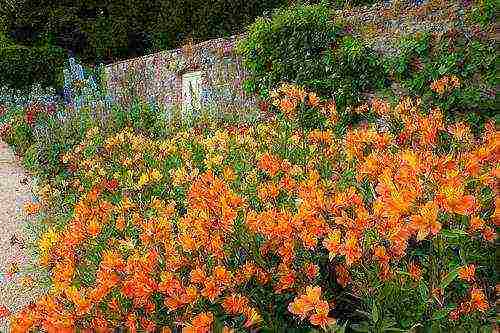
Sowing seeds
Considering alstroemeria and how to grow it, attention should be paid to the fact that seeds can be used for this. At the same time, we highlight the following important points:
- When using seeds, flowering occurs only in the third year. Therefore, you will have to wait long enough. Alstroemeria from seed in a pot grown due to the fact that flowering occurs much faster when planted indoors. This is due to the fact that only a favorable environment allows the plant to develop quickly enough;
- You can sow the plant immediately in the open field. At the same time, the recommended period for planting can be called April-May, when the likelihood of frost is significantly reduced. If you plant seeds in February-March, then flowering can take place in the second year;
- Growing from alstroemeria seeds is carried out as follows: for a start, 2 parts of leaf and 1 part of sod land are taken, after which they are mixed. When choosing a soil, attention is paid to acidity, it should be in the range from 5.5 to 7;
- The seeds can be placed on the ground, pressed a little, and then sprinkled with earth for protection. The seed container can then be sent for stratification;
- Growing the plant in question at home provides for the stratification of seeds within a month. At the same time, it is quite important to maintain the temperature in the range from 2 to 5 degrees Celsius. Seedlings appear within 10-20 days, in some cases, within one month;
- The next step is to plant the seedlings in open ground. The most suitable period can be called May-June, since the threat of frost is significantly reduced. It should be remembered that low temperatures can adversely affect the seedlings, for this reason the plant may not take root.

When choosing the most suitable site for planting a plant, attention should be paid to the fact that the plant loves fertile, well-drained soil with high acidity. Considering How To Grow Alstroemeria From Seeds pay attention that the plant tolerates partial shade well, but can also be planted in sunny areas. However, do not forget that the flower cannot tolerate prolonged drought.
Watch a video about demonstrating the appearance of the alstroemeria plant.
Care features
When considering planting and care, it should be borne in mind that right after planting the plant, proper care should be carried out. Only in this case will the flower take root and begin to bloom.
There are several recommendations for flower care:
- At the time of the growing season, weeding should be constantly carried out. Only in this case it is possible to exclude the possibility that the plant will not receive the required amount of moisture and nutrients;
- It is very important to keep the soil moist at all times.That is why it is recommended to periodically check soil moisture and water the plant as needed. However, you need to avoid the situation when the plant is in a large puddle for a long period;
- It is necessary to do periodic feeding of the plant in order for it to develop rapidly. On the market you can find many different drugs that can enhance the plant.
Read about ficus care.
And also about planting action and caring for it.
When considering how to grow alstroemeria at home, we will pay attention to the fact that you need to prepare the plant for the winter period. Extreme cold can slow down flower development. Therefore, in the fall, the upper part should be cut off, and the rhizome is dug out. The next step is to dry the rhizomes, which will eliminate rotting at the time of storage.
Reproduction of alstroemeria
The next step after analyzing the issue of sowing alstroemeria seeds is to take care of how to grow alstroemeria at home by dividing the rhizome and its further winter storage. However, it should be borne in mind that separation of a plant that is too young should not be carried out, since in this case it is possible to lose the plant. At the time of the growth of the rhizome, you can get several days without harming the mother plant.
Many years of experience in growing this plant indicates that after dividing the rhizomes, the media should be treated with crushed coal. Only in this case can the likelihood of rotting be excluded. In addition, one should not forget that too small divisions can hurt for a long time. Therefore, the flowering period occurs only in the third year.
In conclusion, we note the moment that flowering takes place from the end of June to August. With proper care, flowering takes place abundantly, for which complex fertilizers should also be used. The acidity of the soil should be constantly monitored. As practice shows, a significant decrease in acidity causes the development of leaf chlorosis.
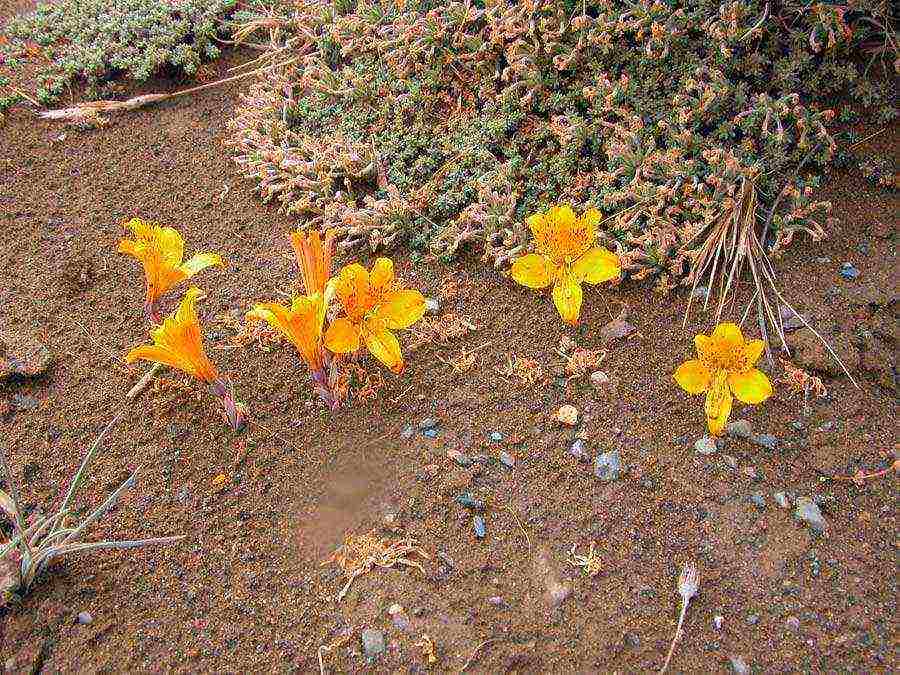
In general, we can say that the plant is not very affected by diseases. The only, but serious threat can be called the fact that if the humidity is too high, the rhizome decays. Therefore, attention should be paid to the effectiveness of drainage. After prolonged torrential rains, watering should not be performed, and it is also recommended to spray the plant with a foundationol solution. Processing is carried out 2-3 times a week. On sale you can find a lot of products that protect the plant from common parasites.
Share your experience of growing alstroemeria from seeds in the comments. And also watch a demonstration of white alstroemeria in the video below.
Alstroemeria is also called the "lily of the Incas", as it visually looks like an orchid or lily. This perennial, exotic plant from South America is especially prized for its charming, multi-colored flowers and long bloom. The inner leaves of alstroemeria are covered with contrasting stripes and specks, which makes the plant even more attractive for landscaping the garden.
How to grow alstroemeria from seeds?
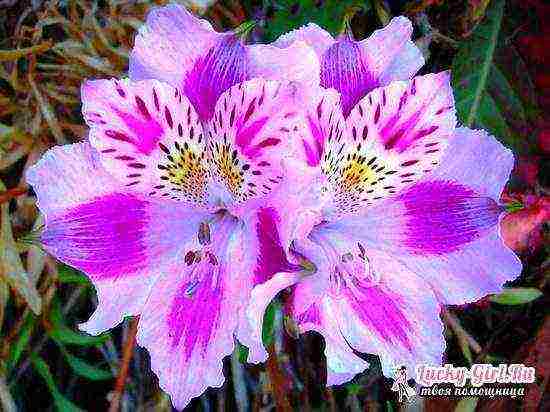
It is most convenient to grow alstroemeria from seeds. But keep in mind that with this method, flowering will come only after 3 years (and maybe even later). Seedlings can be planted in mid-spring directly into open soil. If you are going to sow seeds for seedlings, this should be done in late winter - early spring. Then flowering will begin faster.
For sowing, a mixture of turf and leaf substrate (1: 2) is ideal. Cover the container with the planted seeds with plastic wrap and place for a month in a room where the temperature does not exceed 5 degrees. This method is called stratification and is necessary to accelerate germination, which will occur in 15 to 20 days.
You can transplant alstroemeria seedlings into open ground in early June, when the threat of frost has passed. Fertile, acidic and well-drained land is ideal for replanting. Choose a place with moderate lighting and shading. True, according to gardeners, it is better to plant alstroemeria in sunny areas without drafts.
Read also:
- Alstroemeria: planting and care
- Voodoo Lily (Amorphophallus)
Important rules for planting and caring for alstroemeria

"Lily of the Incas" undemanding to care for, but not frost-resistant flower. It can be grown outdoors in warm countries without heavy rains. In cold areas, where the soil freezes deep enough, in the autumn period, it is recommended to transplant alstroemeria into a large container and move it to the veranda or to the basement.
In regions that are famous for shallow freezing of the earth, when growing a plant, it is better to provide it with good drainage, and during frosts, cover the roots with a lot of straw. After the first frost, it is recommended to cut off the upper part of the plant, and cover the rhizome with dry leaves, on top of which put plastic wrap and earth.
In the case when the roots of alstroemeria grown from seeds have grown strongly, they are divided into several parts and treated with a weak solution of potassium permanganate or coal powder. Plant the plant carefully, trying not to damage the young sprouts.
Alstroemeria needs moderate watering. Make sure that the water does not stagnate, otherwise, this will lead to decay of the rhizome. Also, the "lily of the Incas" every week needs organic and mineral fertilizers, which alternate. Normal soil acidity is also an urgent issue when growing alstroemeria, because its decrease leads to leaf chlorosis. Also, remember to weed during the growing season.
This flower is rarely exposed to diseases and pests. But in the absence of good drainage, gray rot can strike Altroemeria. To prevent disease, after heavy rains, water the rhizome and spray the plant itself with a solution of any fungicide. This treatment should be carried out 3 times, then take a break for a week. In addition, the plant can infect slugs, caterpillars, spider mites, thrips and various beetles. You can get rid of parasites using a variety of chemicals.
Alstroemeria flower: photo

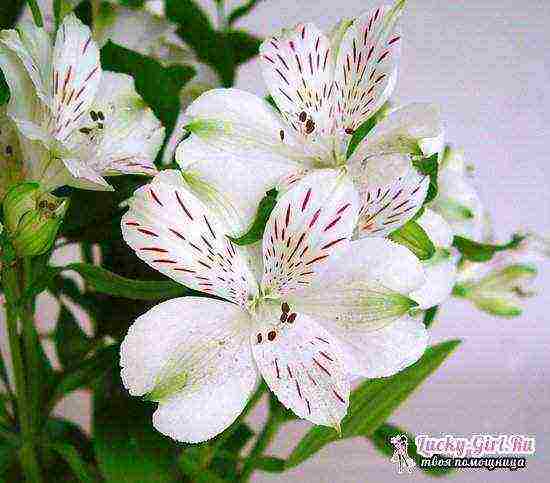
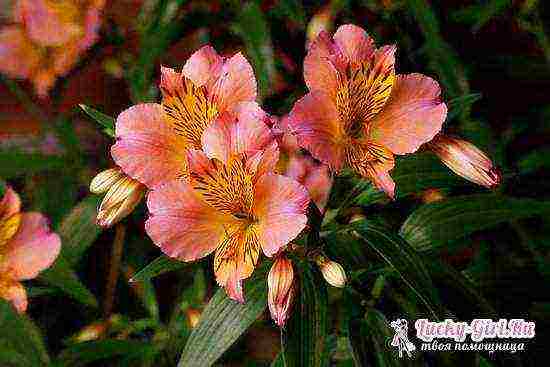
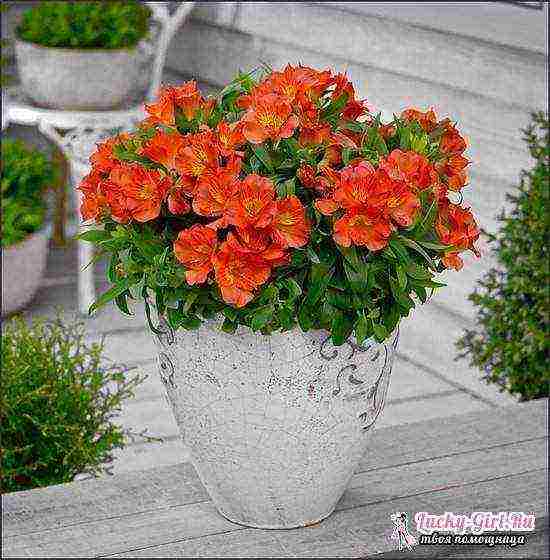
Read also:
- Iberis: growing from seed
- Liana morning glory: planting and care
- Pansies: planting and care
- Lily of the Incas: planting and care
Alstroemeria is an incredibly beautiful plant that grows up to 1.5 m in height. There are many varieties of it, which allows you to choose a flower to your taste. Planting and grooming tips are due in large part to the tropical origins of alstroemeria. It is more suitable for growing in warmer climates.
Indoor plants take a lot of time and effort. And at the same time, certain knowledge in this field of activity is required from the florist. After all, there are indoor flowers in nature, which are distinguished by their beautiful color and features in care, but few people know about them. Alstroemeria is considered such an example. On the stem of this plant, up to fifteen inflorescences are formed, not very large in size. The foliage on the plant is narrow, medium in size. It blooms almost all summer, in a cut form it can show off for more than two weeks. Today you see Alstroemeria growing from seeds at home, rules for care.

Growing requirements
The plant prefers a moderate temperature regime. In winter, fifteen degrees of heat is enough for her, in the summer season - about twenty-two. Failure to comply with such a regime can cause negative manifestations - in winter, buds will not form, in summer, buds will quickly shatter and the flower will wither.
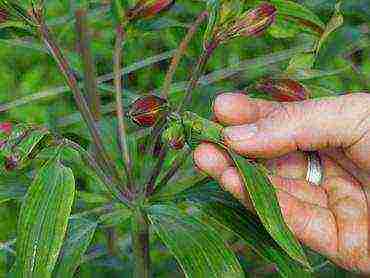
Alstroemeria loves bright places, regular watering, the use of fertilizers containing potassium and phosphorus. The flower does not tolerate nitrogen well - there is an enhanced process of growth of green mass and the disappearance of buds. For good flowering, it is necessary to artificially increase daylight hours, maintaining it with fluorescent lighting for at least fourteen hours.

The regularity of summer watering should take place as needed, when the soil dries up. By winter, their number decreases. The flower does not tolerate the accumulation of moisture at the roots. But during the period of growth and flowering, the land should always be slightly moist.

The plant can be replanted annually in the spring. The soil composition is prepared from leafy earth (two parts) and one share of peat, humus, perlite and pine bark. The acidity is not too high, drainage is required.
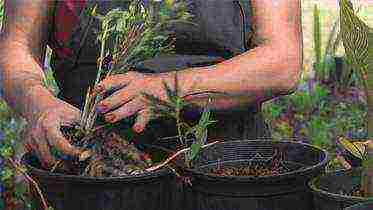
Breeding a plant with seeds
Sowing must be done in February. In May, the seedlings can already be transferred to the ground. Seedling growing method provides planting material that can be an excellent decoration for your window. On the eve of sowing, the seed fund is soaked for several hours, then planted in containers filled with sand and leafy soil. Planting is carried out one seed per individual hole, the interval is maintained at three centimeters. After planting, watering is carried out, and the container is covered with polyethylene.

Seedlings under favorable conditions will appear in a week and a half. After the formation of the second pair of leaves, the seedlings must be hardened.

This growing method is suitable for plants that are planned for indoor breeding. But for outdoor seedlings, it is necessary to germinate seeds at a temperature of no more than five degrees Celsius. Losses during germination will be fifty percent of the total sowing. But the sprouts will be resistant to temperature changes and even be able to withstand light frosts.
When caring for a plant, do not forget about gloves, because alstroemeria with its juice can irritate the skin. It is better to select a large pot for growing so that the root system can develop normally.
These are the features of growing alstroemeria. It should be added that in the course of cultivation, weeding is necessarily carried out. Plants on the street are pruned before the winter period. The roots are dug up and dried thoroughly. Storage is organized in a cellar or basement, the temperature should not be below zero.


